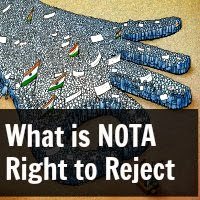Friends recently questions are being asked in interviews about NOTA, i.e. none of the above The Supreme Court of India on 27 September 2013 held that citizens have the right to reject all candidates contesting an election. From SSB point of view this is an important issue. Let’s have a look what are the provisions of this right and how it will affect our elections in near future.
Existing Provisions in Representation of People Act
Under the existing provisions of Section 49(O) of the Representation of People Act, a voter who after coming to a polling booth does not want to cast his vote, has to inform the presiding officer of his intention of not voting, who in turn would make an entry in the relevant rule book after taking the signature of the said elector. It violates the concept of secret ballot.
Initiatives:-The Election Commission of India (ECI) moved the Law Ministry in 2001 for an amendment to the rules to provide for a button in electronic voting machines in order to protect the identity and secrecy of a voter who does not want to vote for any candidate. That was the equivalent of the unmarked ballot paper of the earlier era. The ECI received no response to the proposal for amending the said rule, In 2004, the then Chief Election Commissioner, T.S. Krishnamurthy, reiterated the proposal after christening the button as ‘none of the above’ but, for the first time, clearly articulating that it was to “to enable a voter to reject all the candidates, if he chooses so.” By then, the People’s Union for Civil Liberties (PUCL) an NGO had already moved the Supreme Court in the matter. And in September 2013 The court passed order on a Public Interest Litigation (PIL) filed by PUCL.
Court judgment and its implementation
- A bench headed by Chief Justice P Sathasivam while pronouncing the judgment viewed that negative voting would foster purity and vibrancy of elections .
- It also ensures wide participation as people who are not satisfied with the candidates in the fray would also turn up to express their opinion rejecting contestants.
- After that Election Commission of India Approved None of the Above Option in EVMs and Ballot Papers. The NOTA option was made mandatory by the Supreme Court of India on 27 September 2013 and gave the direction to the Election Commission of India to provide none of the above options at the end of the list of candidates contesting an election in a constituency.
- The Election Commission of India on 28 October 2013 clarified that if the number of electors who had utilized the NOTA (None of the above candidates) option in the EVM or Ballot paper exceeded the votes polled by any of the candidates, the candidate with the highest number of votes would be declared winner.
Objectives
- Sole objective of giving the voter a wider choice.
- Democracy is all about choices. So, voters will be empowered by this right of negative voting.
- Negative voting will send a clear signal to political parties and candidates as to what the voters think about them.
- The concept of negative voting is prevalent in 13 countries. Even in India parliamentarians are given an option to press the button for abstaining while voting takes place in the Parliament.
- The right to reject candidates in elections is part of fundamental right given by the Constitution in article 19 (freedom of speech and expression).
Effects
- Presently, it will only enable a voter not to vote in favour of any candidate. So the votes recorded against this button will have the same effect as the ‘invalid’ votes of the ballot paper time and would have no role in determining the winner.
- With EVMs, the ‘invalid vote’ category got eliminated as mistakes like wrong marking and multiple marking became a thing of the past. Now, with this button that column will come back to life.
- it as it may increase voter turnout, an aspect which the Supreme Court judges also pointed out.
- it will make parties more responsible, which will nominate better candidates. The judges themselves pointed out that it can widen participation and curb impersonation.
Future
From here the next logical step will be one of raising the status of the button to that of “negative vote” with consequences, in other words a vote for ‘rejection’ of all candidates, instead of its current status of merely being “no vote or negative vote. It will indeed compel the political parties to nominate a sound candidate, if parties keep imposing tainted candidates on voters or, while selecting candidates, regardless their performance or integrity, the voter can hit back with NOTA. A time will come with demands for fresh election with a fresh set of candidates if, in the first election, NOTA scores the highest votes.
Also Read
- How Does an Aircraft Flies?
- SSB Interview Technical Questions for Engineering Students
- Article on Egypt Unrest
- Syrian Civil War And Its Effects On International Politics
 Gaurav Vaishnav, Editorial Team
Gaurav Vaishnav, Editorial TeamGaurav is a defence aspirant and appeared for SSB interview 8 times, he is here to share his experience of different selection centres across India. Mail us to join our editorial team now.













